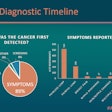The 2004 American Healthcare Radiology Administrators (AHRA) meeting in Boston from July 31 to August 5 offered a broad spectrum of workshops and presentations on topics ranging from electronic imaging and technology to marketing, management, and operations. In addition, 200 vendors displayed a wide range of radiology products and services to attendees in the Hynes Convention Center exhibit hall.
Reflecting the plethora of tasks and competencies that radiology administrators are faced with on a daily basis, breakout sessions and workshops covered a wide range of subjects, from avoiding MRI disasters to dealing with imaging turf struggles. The AHRA conference stressed the importance of a multifaceted approach to management with an emphasis on technology, coding, retention, compliance, revenue, contracts, and training.
Meeting highlights
Maureen Brooks, corporate compliance officer for Radiology Practice Management in Long Beach, CA, shared her thoughts on creating compliance programs that reduce both fiscal and regulatory liabilities.
According to Brooks, a thorough compliance program can reduce areas of potential fraud and abuse, mitigate possible HIPAA violations, shield a practice from employee abuse litigation, and provide valuable feedback on payor denials.
Imaging center start-up veteran Lisa Brockett, chief operating officer and co-founder of Trinity Health Care, a Newport Beach, CA-based diagnostic imaging center management firm, provided insider tips on crafting a compelling imaging center business plan.
She broke down each step a practice needs to take to generate a powerful financial pro forma. According to Brockett, getting good data on every aspect of a proposed venture, refining it to its smallest elements, and presenting it in a comprehensive business plan increases the likelihood that an imaging center will find the financing it needs.
Jay Mazurowski, director of radiology at Concord Hospital in Concord, NH, disclosed the important lessons of PACS implementation through his experiences at three different institutions. According to Mazurowski, every PACS installation is unique because each facility has its own mix of modalities, systems, and cultures that are different.
However, a pre-PACS assessment of an institution's physical space, network infrastructure, modalities, finances, and information systems can help ensure a successful project.
He said that performing a detailed pre-PACS assessment of is a powerful tool that provides a facility with multiple benefits, such as:
- A detailed assessment of the current physical and network infrastructure for future planning.
- The ability to anticipate future trouble spots and expenses, and prevent or reduce potential database or image retrieval errors.
- A track on which the project can run.
- Education to the stakeholders in a PACS project.
- Financial planning for the scope of the overall project.
Mammography has come under increasing fire from malpractice litigators at the same time U.S. demographics have increased the number of women seeking screening mammograms. Bonnie Rush, president of Breast Imaging Specialists in San Diego, offered a sobering assessment of the state of U.S. mammography practice in her presentation at the meeting.
According to Rush, the number of claims against radiologists hasn't necessarily increased, but jury awards have gotten larger. Her research also found that the most common reasons for a patient not to sue is that they felt the provider listened, they felt they were adequately informed, and they felt the provider cared.
As such, she advocated the creation of a proactive program by breast imaging centers to establish protocols to ensure that the communication loop between the radiologist, the referring physician, and the patient is closed, and that their roles are understood by all parties. By establishing a rapport with both the patients and the referring physicians, a practice will find that the referring physicians are more apt to work with the radiologists, and the patients will be less likely to sue, Rush said.
Opening a new imaging center is a considerable undertaking, and marketing for an opening can be a formidable task as well, but establishing timelines can make the project much less daunting, according to a pair of imaging center marketers.
Deborah Mourey, director of sales and marketing at IDE Radiology, a subsidiary of Dallas-based imaging services provider Radiologix, and Marianne Henderson, director of sales and marketing at Pacific Imaging and Valley Radiology in San Francisco, offered their insights on marketing an imaging center opening.
They believe that a successful campaign should begin six months before the scheduled opening of the facility. Utilizing a 180-day timeline, a new facility can accomplish marketing tasks as varied as a situation and competitive analysis of the local economy, healthcare and payor environment to holding a series of open-house events for referring physicians and the community.
Modality equipment purchases in radiology can easily be a six- or seven-figure deal, and the equipment is expected to last five to seven years. Under these circumstances, making a purchase decision on the basis of criteria other than verified facts is a bad idea.
Negotiating the best deal for a practice doesn't take the business acumen of Donald Trump, however. What it does take is a fair amount of research and the ability to set terms and conditions, according to a couple of veteran imaging equipment negotiators.
Georgann Bruski, a radiologic technologist and manager of invasive cardiology at Beth Israel Deaconess Medical Center in Boston, and Sara Cutler, president of Advance Healthcare Consulting in Schenectady, NY, provided AHRA attendees with strategies for getting the best value in a deal.
Their experience has taught them that defining the scope and parameter of equipment needs, financial capabilities, and vendor interaction creates a level playing field for both customer and supplier.
"The vendors get together, they strategize, they plan, and they decide how they're going to get the deal," Bruski said. "You know what? You need to get together, you need to strategize, and you have to figure out who's going to get the deal and how you're going to get the best deal."
Recognition and awards
In addition to workshops and breakout sessions, the AHRA honored several of its members for their contributions in 2004. Steven Clevenger of Emory Crawford Long Hospital in Atlanta and Jay Mazurowski were named AHRA fellows. Roland Rhynus received the society's Gold Award for his contributions to the profession of imaging and healthcare administration.
LuAnn Epperson of Northeast Medical Center in Bonham, TX; Joanne Fisher, of Sun Health in Sun City, AZ; and Jennifer Jones, of Mercy Memorial Health Center in Ardmore, OK, were the recipients of Osborne Scholarships. The 2004 GE Healthcare Award for Excellence recipients were Betty Kay Adams of Rankin Medical Center in Brandon, MS; Rebecca Allen of St. Luke East Hospital in Fort Thomas, KY; Terry Dowd of Banner Baywood Medical Center in Mesa, AZ; John-Hans Giga of Clinton Memorial Hospital in Wilmington, OH; and Penny Olivi of the University of Maryland Medical Center in Baltimore.
Lynn McVey, of St. Joseph's University Medical Center in Paterson, NJ, was named as the 2004 president-elect. She will take over the presidency of the organization from the 2004 president, Roberta Edge of Sutter Gould Medical Foundation in Modesto, CA, at the society's 2005 annual meeting and exposition.
The 2005 AHRA meeting will be held August 7-11 at the Henry B. Gonzalez Convention Center in San Antonio.
By Jonathan S. Batchelor
AuntMinnie.com staff writer
September 16, 2004
Copyright © 2004 AuntMinnie.com



















